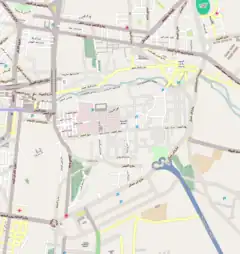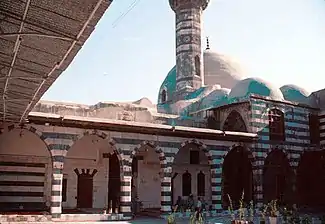| Murad Pasha Mosque Murat Paşa Camii جَامِع مُرَاد بَاشَا | |
|---|---|
 Murad Pasha Mosque in 1880 | |
| Religion | |
| Affiliation | Islam |
| Region | Levant |
| Status | Active |
| Location | |
| Location | Al-Midan, Damascus, Syria |
 Location within Old Damascus | |
| Geographic coordinates | 33°30′13″N 36°18′05″E / 33.503598°N 36.301412°E |
| Architecture | |
| Type | Mosque |
| Style | Ottoman architecture |
| Completed | 1568 |
| Specifications | |
| Dome(s) | 1 |
| Minaret(s) | 1 |
| Materials | Stone, marble, tile |
The Murad Pasha Mosque (Arabic: جَامِع مُرَاد بَاشَا, romanized: Jāmiʿ Murād Bāšā; Turkish: Murat Paşa Camii) is an early Ottoman-era mosque and mausoleum in Damascus, Syria, located in the Suwayqa sector of the Al-Midan quarter. The mosque was erected and named after Murad Pasha, who served as the Ottoman governor ("wali") of Damascus between 1568-1569. The mosque was built in 1568.[1] The mosque is also known as the Naqshbandi Mosque (Arabic: جَامِع النَّقْشَبَنْدِي, romanized: Jāmiʿ an-Naqšabandī) after the Naqshbandi sufi order which it served as a center for.[2]
Architecture
The mosque is built in the style of Ottoman mosques, rather than the prevalent styles in Arab lands. The building is noted for its similarities with other Ottoman-era mosques in Damascus, including the Sulaymaniyya Takiyya Mosque and the later Darwish Pasha Mosque.[1] The walls of the mosque were built using alternating lines of black and white stones.[3] The mosque is built around a large courtyard ("sahn"), which features an elaborate fountain that was used for ablution ("wudu"). The courtyard is surrounded by an arcade of domed cells ("riwaq"), which were used as sleeping rooms by students and scholars at the mosque. The structure's walls are decorated with elaborate qashani tile panels. The interior rectangular prayer hall is roofed by a typical Ottoman-style lead-covered dome.[2] The prominent hexagonal-shaped minaret is singled out as the only element built in "the image of the minarets of the Arab lands."[1] The mosque also holds in one of its corners the mausoleum where Murad Pasha was buried. The mosque's main gate holds kufic inscriptions that mention the mosque's construction date and its patron's name.[3]
Road to Mecca
.jpg.webp)
During the Mameluke rule, which lasted from 1260 to 1516, the main city for the gathering of pilgrims of the region for their five-week journey to Mecca, was Damascus.[4] The city was viewed as a holy one because of the remains in the Umayyad Mosque. Damascus kept this role during the Ottoman rule (1516-1918). It is for this exact reason Damascus was referred to as the "Gateway to Hajj".[5] Every year about thirty thousand pilgrims gathered outside the western walls of the Old Town, from where they started their journey. The Murad Pasha Mosque was the first example of an Ottoman-style building along the Road to Mecca, which is why even though the design of the Minaret followed local and traditional patterns.[4] The complex, which included a hospice for poor pilgrims, was built on an angle. As a consequence of this, the Mosque's complex is exceptionally visible.[4]
Location

The Murad Pasha Mosque is situated southwest of the old city of Damascus. From the main (western) entrance of al-Hamidiyeh Market, follow the main street, Aal albeit that runs to the south-southeast along the original boundary of the old city walls.[6] This street will pass al-Darwishiyeh Mosque on the right, al-Sibaiyeh Mosque on the right, al-Sinaniyeh Mosque on the left, al-Ajami Mosque on the right, and al-Sabuniyeh Mosque on the right. About one hundred meters beyond this point, a road diverts to the right (southwest), leaving the Murad Pasha Mosque clearly visible on the right.[6]
References
- 1 2 3 Kafescioǧlu, Çiǧdem (1999). ""In The Image of Rūm": Ottoman Architectural Patronage in Sixteenth-Century Aleppo and Damascus". Muqarnas. BRILL. 16: 70–96. doi:10.2307/1523266.
- 1 2 Rihawi, Abdul Qader (1979). Arabic Islamic Architecture in Syria. Damascus: Ministry of Culture and National Heritage. p. 226.
- 1 2 Asawda, Fadi (18 September 2009). "جامع "النقشبندي"... نسخة "التكية السليمانية" في حي السويقة". eSyria.sy. Retrieved 4 March 2011.
- 1 2 3 "Damascus - - The Road to Mecca". www.romeartlover.it. Retrieved 2021-12-15.
- ↑ Shafir, Nir (2020-08-01). "In an Ottoman Holy Land: The Hajj and the Road from Damascus, 1500–1800". History of Religions. 60 (1): 1–36. doi:10.1086/709169. ISSN 0018-2710.
- 1 2 Demeter, Daniel (2014-06-29). "Damascus – Murad Basha Mosque دمشق – جامع مراد باشا". Syria Photo Guide. Retrieved 2021-12-15.



